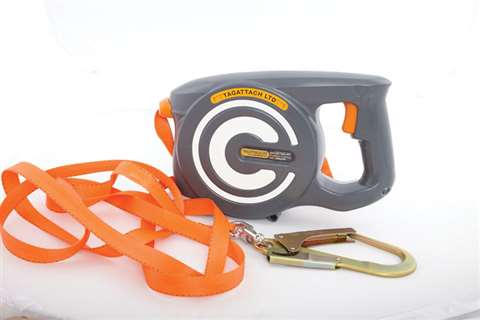Safety equipment and training
02 February 2015

Prevention is the best way to protect workers, however, when accidents do happen, rescue equipment is vital. Laura Hatton finds out more...
Crane safety equipment is designed to help prevent accidents and, in the event of an emergency, help get workers to safety quickly and efficiently. To work effectively, safety rescue equipment for cranes has to be easily accessible and simple to use. To meet the increasing demands for rescue-ready equipment, Tech Safety Lines (TSL), a manufacturer of fall protection systems, offers a range of self-rescue devices for workers at height. Included in the range is the StepWise v-leg fall arrest lanyard, which has a built-in webbed ladder that can be deployed by the fallen worker.
“The ladder is built into the lanyard, not the harness, providing a foothold from which to stand and relieve all pressure from the harness,” a TSL spokesperson says. “Also incorporated into the StepWise lanyard is an anchor point for use in conjunction with the SRK-11 controlled descent device. By using these two tools together, a fallen worker can perform a self-rescue, safely lowering oneself all the way to the ground without assistance from other workers.”
Training is not generally required to use the basic fall protection equipment, such as the StepWise Lanyard. A certain amount of training is, however, required for use of the TSL assisted rescue and self-rescue kits. The courses, which are provided by TSL, cover efficient deployment methods and effective kit preparation, a spokesperson says. TSL also offers a tower crane rescue course, which teaches personnel how to rescue an unconscious victim from anywhere on the tower crane.
“Course objectives include pre-emergency planning, equipment selection and use, victim assessment, anchor selection, safe descent path identification, suspension trauma awareness, communications, patient packaging and extraction, raising and lowering, equipment care and maintenance,” a spokesperson adds.
Tag lines
Safety equipment is also vital for riggers and other workers, especially when guiding a suspended load into position. To help guide a load away from other structures as the crane moves from the pick-up point to the touch-down area, taglines are used. To help increase safety further, Tagattach, a manufacturer of taglines, offers a retractable tagline.
“The Tagattach retractable tagline can be operated with one hand giving the operator control of the load up to 15 metres in height,” a company spokesperson says. “Almost any application that requires the use of a tagline to enable positioning of the load without using hands could benefit from Tagattach products. No formal training is required and many new customers use our online product videos to understand how to operate the units effectively.”
The retractable taglines are suitable for use in a number of construction, heavy engineering, offshore oil and gas, rail and shipping industries, the manufacturer says, and cover an area of lifting safety which isn’t currently covered under EU and US regulations. “We feel very strongly that taglines, where used for load positioning, should be covered under Lifting Operations and Lifting Equipment Regulations (LOLER) regulations,” a company spokesperson says.
Also from Tagattach is the Grip Rope, a fixed length tagline, which has a reflective panel along the length. “This is for use where taglines need to remain attached to aid ground or height operators,” a spokesperson says. “It is a lightweight but strong and highly visible solution.” Grip Rope is available in stock lengths of 3, 5, 7 and 10 metres or custom lengths up to 50 m.
Preventing accidents
Collision avoidance systems are another device that crane companies use to help keep workers safe by preventing crane collisions. The latest equipment from manufacturer SMIE is the ProSite system. It has an LED touch screen display, sensor technology for slew, trolley and hoist movements and up to three anti-collision radio networks. Also from SMIE is the ProSITE site global management software for jobsite management. Functions include real time data of global crane movement, weather and crane activity history and remote by-pass of anti-collision function. A spokesperson from SMIE says, “The benefits [of these products] are safe usage of multiple cranes on site and the protection of surrounding obstacles such as buildings, railways and power lines.”
Another protection device to increase safety on site is the CornerMax sling pad protection from manufacturer Slingmax. The CornerMax sling pad is a protection device that prevents the edge of the load from touching the sling. “It is designed to protect synthetic slings from cutting when the connection point between the sling and the load is not a 90 degree angle,” a company spokesperson says. “In some applications the CornerMax sleeve may be attached to the sling to prevent slippage.”
The CornerMax sleeve is made with high tech fibre, the manufacturer says. “The materials used in the CornerMax pads have good resistance to solvents, acids and alkalis and have high melting points of around 425 degrees Fahrenheit [218 degrees Celsius]. The CornerMax sleeve has excellent resistance to solvents, acids and alkalis. The melt point on the sleeve is around 300 degrees Fahrenheit [149 degrees Celsius].”




